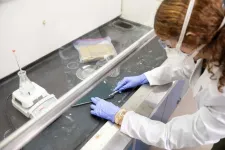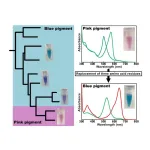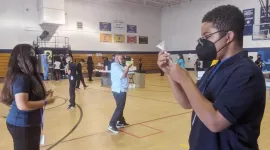(Press-News.org) With teaching methods for reading and writing under constant scrutiny, and high-stakes testing creating intense pressure to teach strictly to state standards, is there still value in whole-class reading?
Two educators believe that whole-class reading should go hand-in-hand with individual instructional reading, and they say it is vital for cultivating a sense of classroom community while developing critical thinking in young minds.
Educators Lynsey Burkins and Franki Sibberson, both teachers and educators from Ohio, have published a book called In Community With Readers, showing why whole-class activities are crucial for fostering independent thinkers, and they urge other educators to move away from strictly using standards as a checklist for teaching.
“For years, we have read and listened to experts who viewed whole-class instruction as the time for explicit instruction, a time when teachers took the reins and taught the skills that needed to be taught,” they explain. “Once we let go of some of the traditional thinking around whole-class instruction, we discovered the power in being responsive to our students, rather than scripted in our teaching. We realized we could not create a truly beloved community while holding onto traditional power structures in the classroom.”
Burkins and Sibberson acknowledge that many teachers must teach in ways that meet state standards. But, they argue, standards can be made part of the learning process by inviting the whole class to think about them.
“We know that these whole-class conversations are possible when we, as teachers, know our standards well and study them with a critical lens. That means we make sure not to view them as a checklist of isolated knowledge and skills,” they suggest.
Instead of teaching to pass exams, they suggest learning should be framed around the bigger goals of literacy, such as developing independence, and responding to and understanding various perspectives.
“We want every child to be empowered to ask questions as they read, to answer those questions, to look back to the text for deeper understanding, and to truly hear the perspectives of others in order to confirm or change their thinking,” they explain.
“Standards hold tremendous power in schools. They are often used not just to dictate what we teach, but how we teach it, for how long, and what materials we use to do so. As teachers, we can take back some of this power that is often given to standards by knowing what they say and what they do not say.”
“It is important to read the standards with the goal of supporting students in becoming intellectual citizens instead of only preparing them for a grade-level test.”
While some educators remain divided on the merits of individual reading and class reading, Burkins and Sibberson promote whole-class instruction and independent reading as going hand-in-hand. They believe that with planning and consideration, during mini-lessons and read-aloud sessions students can take their reading skills from their independent reading and access the knowledge of others to expand their understanding of texts.
“We believe strongly that all of our work in whole-class instruction must be both intellectual and joyful,” they say. “Reading itself should be joyful, but there is nothing like watching a reader or a group of readers unlock all the pieces a text has to offer and witness that joy in new understandings.”
To achieve this, Burkins and Sibberson say there first has to be a shift from the traditional power of teacher-led mini-lessons and read-aloud to community-centered lessons. For students to learn the power of intellectual discourse and discussion and learning from others, teachers need to facilitate and make space for each student to bring their own experiences to the conversations.
“Teaching our students to ask important questions as they read is essential. We want them to experience reading as a joyful act, and also as a critical one that helps them to understand the power structures of their world. We believe strongly that it is this beloved community that allows our students to become readers who think deeply about their reading, are confident to share their thinking, and who value the perspectives of others,” they explain.
To make whole-class teaching feel relevant and purposeful to their students, Burkins and Sibberson say there are concrete actions teachers can take.
Recommendations include sharing goals openly, honestly, and often with students; listening closely to students as they interact in lessons, noting the power dynamics and addressing them with teaching when we see a need; honoring students’ conjectures and experiences with texts and building on their questions, observations, and interests.
They say educators should invite readers to ask deep, meaningful questions as they read together and examine power, inequities, and issues of social justice. To enable this, the authors also highlight the importance of choosing appropriate texts for whole-group instruction which reflect the diverse identities in each classroom, as this has the power to engage or disengage readers.
“We have to be so intentional when we invite students to join conversations and to try new skills and strategies in their reading lives,” they explain. “The aim is to create a space where powerful, co-constructed meaning-making happens because a diverse group of readers learns how to think, talk, listen, and reflect together as a community.”
END
Why these educators believe whole-class reading creates a sense of community in the classroom
2024-08-19
ELSE PRESS RELEASES FROM THIS DATE:
Researchers develop an instant version of trendy, golden turmeric milk
2024-08-18
DENVER, Aug. 18, 2024 — If you’ve visited a trendy café in the past few years, you might have noticed “golden” turmeric milk on the menu. Though recently advertised as a caffeine-free, healthy coffee alternative, the drink is a fancified version of haldi doodh — a traditional Indian beverage often used as an at-home cold remedy. And now, researchers have developed an efficient method to make a plant-based, instant version that maintains the beneficial properties of the ingredients while also extending its shelf life.
The researchers will present their results at the fall meeting of the American Chemical Society (ACS). ...
Peering into the mind of artificial intelligence to make better antibiotics
2024-08-18
DENVER, Aug. 18, 2024 — Artificial intelligence (AI) has exploded in popularity. It powers models that help us drive vehicles, proofread emails and even design new molecules for medications. But just like a human, it’s hard to read AI’s mind. Explainable AI (XAI), a subset of the technology, could help us do just that by justifying a model’s decisions. And now, researchers are using XAI to not only scrutinize predictive AI models more closely, but also to peer deeper into the field of chemistry.
The researchers will present ...
Evidence stacks up for poisonous books containing toxic dyes
2024-08-18
DENVER, Aug. 18, 2024 — If you come across brightly colored, cloth-bound books from the Victorian era, you might want to handle them gently, or even steer clear altogether. Some of their attractive hues come from dyes that could pose a health risk to readers, collectors or librarians. The latest research on these poisonous books used three techniques — including one that hasn’t previously been applied to books — to assess dangerous dyes in a university collection and found some volumes may be unsafe to handle.
The researchers will present their results at the fall meeting of the American Chemical Society (ACS). ACS Fall 2024 is a hybrid meeting being ...
Novel photoreceptor sheds light on how cyanobacteria see color
2024-08-17
Tokyo, Japan – Scientists from Tokyo Metropolitan University have identified a new photoreceptor in cyanobacteria with a modification in part of its structure which makes it sensitive to green/teal light. The photoreceptor belongs in a family usually sensitive to red/green light in the environment. They identified the parts of its amino acid structure responsible for this behavior; editing them helped restore sensitivity to red and green light, a remarkable example of molecular “plasticity” in action.
Cyanobacteria, also known as blue-green algae, are phenomenally important players ...
The bee’s knees: New tests created to find fake honey
2024-08-17
Researchers led by Cranfield University have developed new ways to detect sugar syrup adulteration in honey, paving the way for fast and accurate tests to discover fake products.
There is growing consumer demand for honey, with £89.8 million worth of honey imported to the UK in 2023. But as a high-value product it is vulnerable to fraud, with syrups added to dilute the pure honey – a report from the European Commission in 2023 found 46% of 147 honey samples tested were likely to have been adulterated with cheap plant syrups.
Because honey’s characteristics vary due to sources of nectar, season of harvest and ...
Sustainably reducing inappropriate IV use by more than a third
2024-08-17
Sustainably reducing inappropriate IV use by more than a third
Reasearch led by Amsterdam UMC, across more than 5 years and 1100 patients has demonstrated a strategy for reducing inappropriate IV use by a third, an effect that was sustained across the five-year period. This should also lead to reduction in the associated infections that effect one in ten patients. These results are published today in The Lancet eClinicalMedicine.
"Infections caused by both IVs and catheters occur in more than 10% of patients and studies indicate that up to a quarter are not necessary. Simply, this means that patients are placed at ...
UAF scientists discover phenomenon impacting Earth’s radiation belts
2024-08-16
Two University of Alaska Fairbanks scientists have discovered a new type of “whistler,” an electromagnetic wave that carries a substantial amount of lightning energy to the Earth’s magnetosphere.
The research is published today in Science Advances.
Vikas Sonwalkar, a professor emeritus, and Amani Reddy, an assistant professor, discovered the new type of wave. The wave carries lightning energy, which enters the ionosphere at low latitudes, to the magnetosphere. The energy is reflected upward by the ionosphere’s ...
New AI tool captures how proteins behave in context
2024-08-16
A fish on land still waves its fins, but the results are markedly different when that fish is in water. Attributed to renowned computer scientist Alan Kay, the analogy is used to illustrate the power of context in illuminating questions under investigation.
In a first for the field of artificial intelligence (AI), a tool called PINNACLE embodies Kay’s insight when it comes to understanding the behavior of proteins in their proper context as determined by the tissues and cells in which these proteins act and ...
Researchers investigate parent perceptions of virtual learning
2024-08-16
In response to the COVID-19 pandemic, a majority of schools across the U.S. shifted to virtual learning. In a new study, published in Social Education Research, researchers conducted interviews with parents of students who attended middle or high schools to understand how virtual learning impacted their daily routines, stress levels, and the academic performance of the children.
The transition to virtual learning necessitated the creation of online lessons in a very short time period and with limited training of teachers. As a result, parents and students had to deal with unexpected changes in their home lives and learning environments.
“Virtual learning will not be limited ...
Ancient DNA reveals Indigenous dog lineages found at Jamestown, Virginia
2024-08-16
Previous scientific studies have indicated that North American dog lineages were replaced with European ones between 1492 and the present day. To better understand the timing of this replacement, researchers from the University of Illinois Urbana-Champaign and the University of Iowa sequenced mitochondrial DNA from archaeological dogs. Their findings suggest a complex social history of dogs during the early colonial period.
Europeans and Native Americans valued their dogs as companion animals, using them for similar work and as symbols of identity. Consequently, ...






